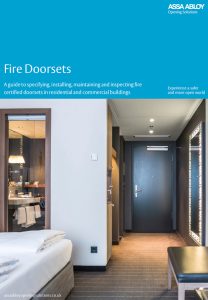ASSA ABLOY Opening Solutions UK & Ireland and fire door manufacturer JELD-WEN have both released guidance to mark the start of Fire Door Safety Week (31 October – 4 November).
Fire Door Guide
 ASSA ABLOY Opening Solutions UK & Ireland is urging those involved with the specification, installation, and maintenance of fire doors to educate themselves by reviewing its comprehensive Fire Door Guide.
ASSA ABLOY Opening Solutions UK & Ireland is urging those involved with the specification, installation, and maintenance of fire doors to educate themselves by reviewing its comprehensive Fire Door Guide.
Brian Sofley, Managing Director at ASSA ABLOY Opening Solutions, explained: “We understand the pressure the industry feels to deliver services faster than ever, at the lowest price point possible. However, this could potentially lead to specification errors with fire safety products, causing ongoing installation and maintenance issues.
“As fire doors are one of the most important safety features in a building, the impact that this can have can be devastating, and in some instances mean the loss of life.
“That’s why we are looking to impart our extensive knowledge on this subject this Fire Door Safety Week, and ultimately help to make buildings safer now and in the future – aligning with the objectives of the Building Safety Act 2022, which we wholeheartedly support.”
As well as providing access around the property, fire doors are a critical part of the fire compartmentation requirement. New regulations being introduced to the Regulatory Reform (Fire Safety) Order 2005 (Fire Safety Order) contain a requirement for responsible persons in buildings above 11 metres in height to provide additional safety measures.
This includes things such as providing occupants with fire safety instructions and information on the importance of fire doors. Responsible persons will also be required to undertake annual checks of entrance doors and quarterly checks of all fire doors in common parts.
Sofley added: “Our Fire Door Guide has been created to offer guidance on specifying, installing, maintaining and inspecting fire certified doorsets in residential and commercial buildings, and we hope that it can help raise industry standards and provide greater awareness.”
White Paper ‘Fire Safety: Time to Shut the Door on Risk’
A recent One Poll survey has revealed that 70 per cent of social housing tenants lack confidence in the fire safety of their home and two thirds (68 per cent) do not feel the Government has done enough to improve fire safety over the past five years. Ahead of the imminent Fire Safety (England) Regulations 2022, fire door specialist, JELD-WEN explores the critical role of fire door safety, what’s due to change and what should happen to better protect tenants in a new white paper.
‘Fire Safety: Time to Shut the Door on Risk’ sets out the purpose and effectiveness of fire doors, fire doors regulations, manufacturing, installation and maintenance, before exploring research which looks at confidence amongst the social housing community and wider factors, such as the trade skills gap and housing crisis.
 It sets a benchmark for perceived progress in the industry, noting that just 30 per cent of people living in social housing feel assured that their home is sufficiently protected against the threat of a fire. Crucially, ahead of the Fire Safety (England) Regulations on 23 January 2023, it also highlights some of the additional measures that can help deliver that progress, with a strong focus on enabling a much more rigorous and transparent approach through stages in the fire door safety chain.
It sets a benchmark for perceived progress in the industry, noting that just 30 per cent of people living in social housing feel assured that their home is sufficiently protected against the threat of a fire. Crucially, ahead of the Fire Safety (England) Regulations on 23 January 2023, it also highlights some of the additional measures that can help deliver that progress, with a strong focus on enabling a much more rigorous and transparent approach through stages in the fire door safety chain.
Amongst additional proposed measures, the white paper calls for:
- A legal requirement for all fire door installations and maintenance work to be conducted by qualified installers, validated through a UKAS-accredited certification scheme.
- A mandatory standard which outlines how fire door information should be stored, updated and shared. To include manufacturer data and third-party certification, installation details, maintenance records, and blueprints all stored in an easily accessible digital format.
- A legal requirement to mark every fire door in the UK with its performance and the name of the manufacturer.
Writing on the white paper, Glyn Hauser, R&D Senior Group Manager at JELD-WEN, commented: “Our home is intended to be a safe haven so it’s concerning that millions of social housing tenants still don’t feel that theirs would be adequately protected in the event of fire. While it is our hope that new regulation will help to refocus fire safety standards and build reassurance for tenants, it is our belief that there is still scope to do much more.
“A fire door, for example, can save lives but only when installed and maintained correctly. However, there is still no legal requirement for this critical safety product to be installed or maintained by a person with any specific formal qualification. We also believe the opportunity to apply a standardised or regulated ‘Golden Thread’ approach to the manufacture, installation and maintenance of fire doors could help build better traceability, accountability and trust.”
The launch comes at a pivotal time for the social housing sector, as it prepares to introduce many of the key changes brought in by new regulation – to include quarterly fire door checks and the better provision of fire door safety information.
Indicative of the pressing need for some of these critical measures in respect of fire door safety, JELD-WEN’s research also found:
- Just 25 per cent of social housing tenants state they have a good understanding of fire doors and how they work
- One in five (17 per cent) admit that they couldn’t tell the difference between a fire door and a standard door
- Only a third (32 per cent) feel that fire doors have been adequately maintained in their property
- 22 per cent of social housing tenants report having seen fire doors propped open in their building
- 81 per cent of social housing tenants in London are not convinced about the safety of their home should a fire break out
- Over 52 per cent of respondents do not feel adequately prepared should a fire break out
Hauser added: “Clearly, there is still a huge task ahead when it comes to enabling improved fire safety, particularly in respect to fire doors. This white paper provides information about fire door safety, what is due to change and what we believe should change to elevate standards across the UK. It is our hope that it may prove a valuable resource for those operating in the industry as we work towards a future where every tenant is able to feel safe at home.”
Developing an effective workplace experience is a balancing act.
This years annual insight report delves into the work-life balance we now face in our day-to-day lives. How the new hybrid working world sees us challenge the balance of getting these things right and what workplaces can do to support its colleagues.
Find out how your organisation can get it right by clicking here to download Balanced Workplaces, a Claremont Group Interiors Insight Report Issue 6.




